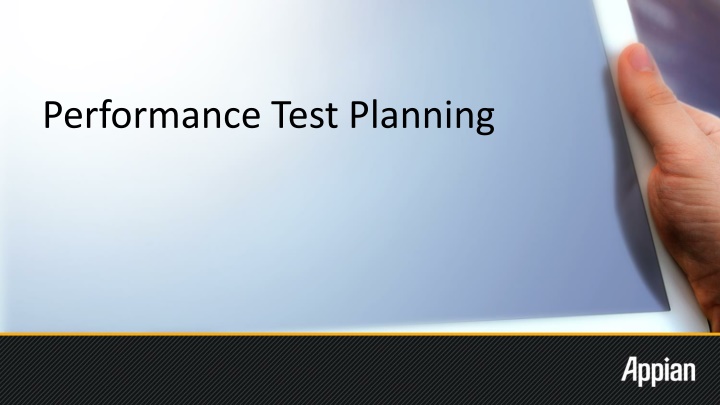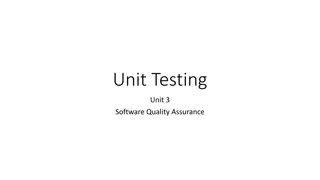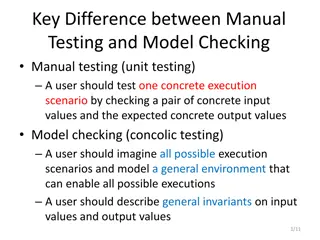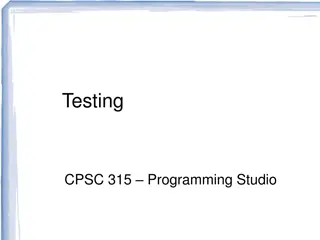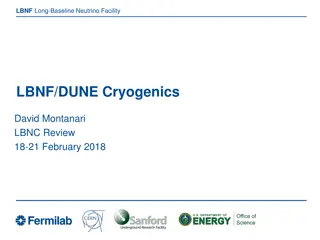Performance Testing Essentials
Dive into the world of performance testing with a focus on planning, risks addressed, testing terminology, web applications, and essential activities. Uncover the importance of testing performance to predict production performance, mitigate potential issues, and plan for future growth. Explore the risks of speed, scalability, and stability that need to be addressed. Understand the terminology, components of web applications, and key activities involved in performance testing.
Uploaded on Feb 23, 2025 | 3 Views
Download Presentation

Please find below an Image/Link to download the presentation.
The content on the website is provided AS IS for your information and personal use only. It may not be sold, licensed, or shared on other websites without obtaining consent from the author.If you encounter any issues during the download, it is possible that the publisher has removed the file from their server.
You are allowed to download the files provided on this website for personal or commercial use, subject to the condition that they are used lawfully. All files are the property of their respective owners.
The content on the website is provided AS IS for your information and personal use only. It may not be sold, licensed, or shared on other websites without obtaining consent from the author.
E N D
Presentation Transcript
Why Test Performance? Predict production performance prior to go-live Mitigate potential performance problems Plan for future growth
Risks Addressed Speed Will pages load fast enough to satisfy end users? How do response times differ between the US and Europe? Scalability Can the application withstand unanticipated peak loads? Can the application store all of the data that will be collected over the life of the application? Stability Will performance be consistent over time? Can heavy loads cause crashes or data corruption?
Performance Testing Terminology Performance Test Measuring the speed, scalability, and/or stability of the application Load Test Performance under initial and projected workload Stress Test Performance under higher-than-expected workload Identification of performance limits and failure points System response to extreme conditions Endurance Test Performance and stability over time
Performance Testing Web Applications Web applications have many components Web server, application server, database, storage, network, etc. Any (or all) can cause poor end-user performance Performance testing and improvement is a team effort Tasks shared by client staff and consultants Responses may involve managers, developers, IT, DBAs, and other roles as needed
Performance Testing Activities 1. Identify stakeholders 2. Educate stakeholders and obtain commitment 3. Identify the test environment 4. Identify acceptance criteria 5. Plan and design tests 6. Configure the test environment 7. Implement the test design 8. Execute the tests 9. Analyze results, report, and retest
Activities Identify stakeholders (Project Manager) Define who needs to be involved and when Includes client staff and consultants Educate stakeholders and obtain commitment (Project Manager) Explain the benefits and costs Add performance testing to the project plan Assign tasks and responsibilities
Activities Identify the test environment (IT) Server: Dedicated clone of production infrastructure Client: Varies from single workstation to distributed/cloud networks Determine tool availability and expertise Identify concerns posed by the environment(s) or tool(s) Identify acceptance criteria (Stakeholders) Determine targets for response time, throughput, and resource utilization Identify critical performance requirements
Activities Plan and design tests (Performance Test Architect) Model realistic usage scenarios Introduce variability and generate test data Define metrics and collection procedures Configure the test environment (IT) Install testing and monitoring tools Deploy the application Run a sample test Implement the test design (Performance Test Engineer) Develop tests based on the design Iteratively validate execution and metric collection
Activities Execute the tests (Performance Test Architect) Validate the test environment, test inputs, and prepopulated data Run tests and monitor execution Validate output and record results Analyze results, report, and retest (Performance Test Architect) Compare results against acceptance criteria Perform root cause analysis Produce reports and recommendations Improve test design based on lessons learned Retest and compare to previous results
Task Plan Task Participants Artifacts Identify stakeholders Project Manager, Stakeholders Project Charter Educate stakeholders and obtain commitment Project Manager, Stakeholders Project Charter Identify the test environment IT, Test Architect Performance Testing Questionnaire Identify acceptance criteria Project Manager, Stakeholders, Test Architect Baseline Acceptance Criteria Plan and design tests Test Architect Performance Test Plan Worksheet Configure the test environment IT Benchmarking Tools Implement the test design Test Engineer JMeter Test Templates Execute the tests Test Architect JMeter Test Templates Analyze results, report, and retest Project Manager, Test Architect, IT Analysis Worksheets, Stakeholder Report Template
